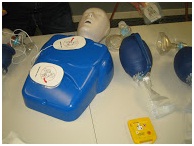
An automated external defibrillator is an important electronic device used to assist patients who are at risk of cardiac arrest. As the name suggests AEDs have automated features. As such, these devices are very different from traditional defibrillators, which work using manual mechanisms. With earlier models, the first aid attendant has to interpret irregular heartbeat patterns of the patient by looking at the readings displayed on the defibrillator’s screen. After analyzing the heart’s rhythm, the medical attendant would determine whether defibrillation is required. If that were necessary, a shock would be delivered to a patient manually. Most people have seen on TV when ER doctors shout the word ‘clear’, before shocking a patient who’s hear has stopped. However, such devices are slowing being replaced by automatic external defibrillators.
When to Use AEDs
Before looking at how automated external defibrillators work, first it would be good to know why these medical devices are used on patients in the first place. AEDs diagnose abnormal heartbeats, which are also known as cardiac arrhythmias. Generally, there are two types of irregular heartbeats, ventricular tachycardia and ventricular fibrillation. The former cardiac arrhythmia causes the heart to beat too fast, while the latter dysfunctional pattern is characterized with chaotic heartbeat that prevents the ventricles from effectively pumping blood. These two arrhythmias can lead to cardiac arrest if not treated. When the heart stops, abruptly due to abnormal rhythms, this can be life threatening. When left untreated, cardiac arrest can lead to irreversible brain damage and even death in a matter of minutes. It is said that a person’s rate of survival drops by seven percent each minute after going into cardiac arrest without being treated with defibrillation. AEDs that literally shock the patient help to stop inconsistent heartbeats, allowing the heart to establish an effective rhythm and avoid going into cardiac arrest.
How AEDs Work
[youtube url=”http://www.youtube.com/watch?v=d9evgNUj_wU” width=”420″ height=”315″]AEDs have an integrated microprocessor, which analyzes the victim’s heart rhythm with adhesive electrodes. The device then audibly advises the operator to shock the patient, if it is necessary. The devices monitor the heart beat patter for ventricular fibrillation and fast ventricular tachycardia. As a result, this device is safe to use and it does not advise the operator to deliver a shock to a patient’s heart rhythm that does not need defibrillation. Adhesive electrodes attached to the victim’s chest are used to deliver the electrical current. The good thing about automated external defibrillators is that they are easy to use and people can learn how to use them in many first aid, first responder, basic life support and CPR classes.
